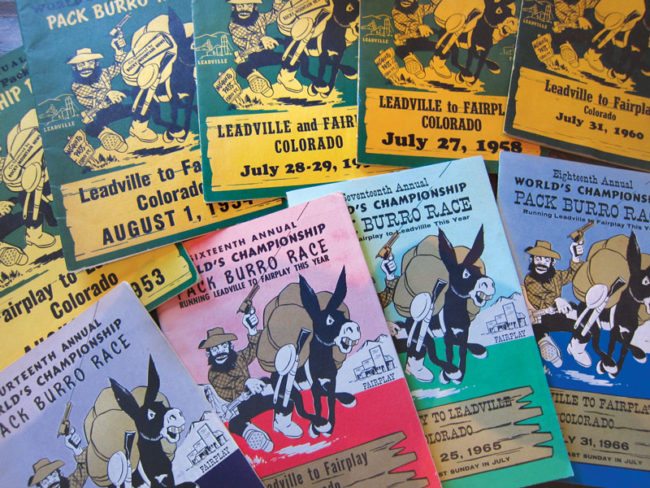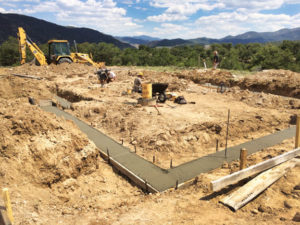By Hal Walter
The phone call came while I was riding the bus back from Leadville after coaching a cross-country meet there. It was Steve Short.
Steve is a physician who lives in Kansas but has a long family history in Westcliffe going back to his childhood. He and wife Whitney have a home in town here, as well as a cabin in the Wet Mountain Valley. Steve said he’d found something at a garage sale that made him think of me. He didn’t want to spoil the surprise by telling me what it was.
When at last I was able to get by his place, I was floored by a collection of nine small booklets from the “World’s Championship Pack-Burro Race,” dated 1954, 1953, 1956, 1958, 1960, 1962, 1964, 1965 and 1966. Decidedly “low-tech” productions, they contained contrasty black-and-white pictures, retro typography and fonts and folksy writings about everything from historical accounts of mining to the Leadville Ice Palace, Molly Brown, the legendary burro Prunes, and even an account of professional baseball player-turned-evangelist Billy Sunday’s visit to a Leadville mining camp.
These books represented not only a small collection of memorabilia, they were also a treasure trove of early information about the race itself. Oddly they made their way into my life about the same time a relatively shallow and silly multi-media extravaganza appeared on CNN, which I found so nauseating it prompted me to deactivate my Facebook account for awhile to avoid seeing mention of it.
 It’s well-documented that the actual first pack-burro race was held in 1949, from Leadville to Fairplay over Mosquito Pass, roughly 23 miles. I’d also long suspected the story of the race being started by miners racing back to town to file their claims at the courthouse to be largely legend. In the 1953 book, one of the race originators actually documents how he and members of the Fairplay Chamber of Commerce and other civic leaders concocted it as a stunt to get more tourists to town for the annual Gold Days celebration.
It’s well-documented that the actual first pack-burro race was held in 1949, from Leadville to Fairplay over Mosquito Pass, roughly 23 miles. I’d also long suspected the story of the race being started by miners racing back to town to file their claims at the courthouse to be largely legend. In the 1953 book, one of the race originators actually documents how he and members of the Fairplay Chamber of Commerce and other civic leaders concocted it as a stunt to get more tourists to town for the annual Gold Days celebration.
The idea, he recalls, “caught on fire” with the group, and next thing they were brainstorming ideas like “Every mining town of the Rocky Mountains will want to be in on it,” as well as the realities of “It’ll cost too much,” and “The altitude is too high.”
Nevertheless, the inaugural race began with a $500 cash prize from the Rocky Mountain News and 21 racers on the old stage coach and toll road over the pass. Melville Sutton won in five hours and 10 minutes.
The booklets contain a number of black-and-white photographs of those early races, with thousands of spectators lining the streets for the start and finish of the race. It struck me that the number of spectators back then far exceeded what we experience these days, but we now have so many more participants in the sport. Many of the racers then jogged the course in boots, jeans and cowboy hats. Today most of the racers are wearing high-tech running gear and shoes.
Early on, some of these competitors were women, and there are pictures of ladies who were still household names in the burro racing culture even when I first started racing in 1980. Names like Edna Miller, Beverly Weeks and Stella Smith.
It’s also chronicled how the race was from Leadville to Fairplay the first four years, but then the towns decided to alternate the start and finish between them, and the Leadville Lions Club got on board with financial help for the event.
[InContentAdTwo]
Another interesting point in the books were the rules, which have been altered over time. One notable point was that all the books state the burros’ saddle and gear were to weigh 25 pounds, and include a pick, pan and shovel. This was in the rules right up to the 1966 publication. Sometime between then and when I started racing, the weight was increased to 33 pounds. Later in the 1990s, the Western Pack-Burro Association changed the rules again to state that miniature burros did not need to carry a set amount of weight. While this rule seems more humane and in the interest of fairness, it possibly gives runners with minis an advantage, not unlike running a feisty Australian shepherd. It occurred to me while reading this, that since pack-burro racing is Colorado’s Summer Heritage Sport, perhaps we should re-adopt the “heritage” rules and go back to having all burros carry the same weight of 25 pounds.
In recent years, with the internet, technology and social media, our sport has been subject to any number of media coverage such as the CNN spots, but none were so colorful as in 1953 when the Rocky Mountain News, Leadville and Fairplay burro race committees, and the Hackett Motor Company of Leadville, staged a grand publicity stunt. An entrant in the race, Max Mappin of Leadville and his burro Bosco, were shipped out to Los Angeles by rail. Then the pair trekked about 1,400 miles back to Leadville, stopping along the way to promote the event, and also wiring dispatches about the trek back to the Rocky Mountain News. Averaging 15 miles a day, and accompanied by buddy Andy Anderson in a Ford pickup supplied by the Leadville auto dealer, they traveled through California, Northern Arizona and New Mexico before arriving back in Colorado and hiking through Trinidad, Pueblo, Colorado Springs, Denver, Georgetown and Breckenridge, and arriving back in Leadville in time for the race. It was labeled an “extraordinary chapter in the annals of burrodom.”
While looking through these books, I thought about how these artifacts – almost all of them were published before I was even born – had brought this sport to life, and had withstood the tests of time and our throw-away society in such good condition, and ultimately came to be in my hands. They bore a certain quality and craftsmanship of the day, and they even smelled good, like museum or library artifacts. While turning them in my hands, I noticed some of the books were set up to be mailed with lines for addressing and return shipping on the back. Then on the back of the 1958 edition, I found a clue in a handwritten return address:
Mr. And Mrs. Walter Smith
P.O. Box 23
Rosita, Colorado
The Smiths were legendary pack burro racers from the area south of Westcliffe. Walter is one of few competitors to ever win the race three times in a row, from 1956-58. And Stella was renowned as one of the early women pioneers of the sport, winning the women’s division in 1955. Walter died in a sawmill accident in 1967 at the age of 54. Years ago when I lived in Wetmore, a family stopped while I was running with my burro along the highway. In the back seat was Stella, probably then in her 70s. I was thrilled to have met her. She died in 1993. She and Walter’s name would surface again and again during my time here in Custer County – legends who simply do not die.
Now I apparently am in possession of their books, and I really don’t know what to do with them. I feel the need to share them, though I don’t want them to disappear in a library or fall into hands that don’t appreciate them or their value.
Perhaps some sort of media stunt could bring this rich history to life.
Hal Walter is the author of “Endurance and Selected Essays on Autism, Neurodiversity and Deep Sport,” available at the Book Haven in Salida and online at amazon.com.



Hi Hal,
With regard to Mr. and Mrs. Smith’s (no relation) memorabilia books, you might consider contacting Shelly Hall as she is now the historian for the Western Pack Burro Ass-ociation. Should you decide to donate these valuable pieces of history, I’m quite sure she will see they are properly preserved to ensure the legacy of the sport.
Dr. Blair Smith
President
Western Pack Burro Ass-ociation